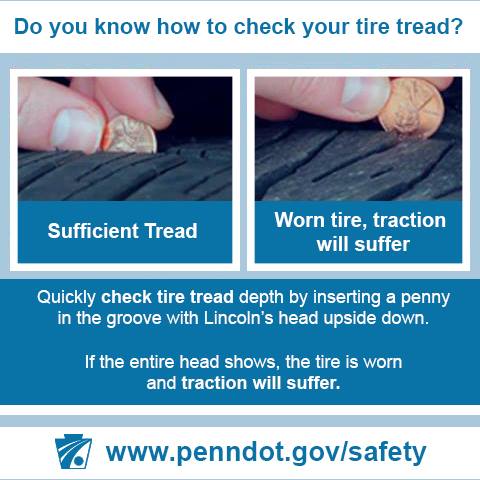Choosing Safety First
You have important choices to make — sometimes even before you start your vehicle — that will affect your safety when you are behind the wheel. Begin by making sure you and your vehicle are "fit to drive."
Vehicle Checks: Preparing to Drive
Tire Safety
Tires are an important part of driving safety. Be sure your tires have adequate tread and air pressure prior to driving your car. Prior to entering the vehicle, check tire pressure using the recommended psi (pounds per square inch) located in the vehicle owner's manual or the driver's side door jamb of the vehicle. Use a tire pressure gauge to check your psi. Check your tires "cold" — before you've driven or at least three hours after you've driven. If your psi is above the number listed on your door jamb, let air out until it matches. If below, add air (or have a tire professional help you) until it reaches the proper number.
 You may also measure tread depth using the penny test. Once every month, or before you embark upon a long road trip, check your tires for wear and damage problems. One easy way to check for wear is by using the penny test.
You may also measure tread depth using the penny test. Once every month, or before you embark upon a long road trip, check your tires for wear and damage problems. One easy way to check for wear is by using the penny test.
- Take a penny and hold Abraham Lincoln's body between your thumb and forefinger.
- Select a point on your tire where the tread appears to be lowest and place Lincoln's head into one of the grooves.
- If any part of Lincoln's head is covered by the tread, you're driving with the safe amount of tread. If your tread gets below that, your car's ability to grip the road in adverse conditions is greatly reduced.
Keep the tools you will need to change your tire in your vehicle at all times, i.e. spare tire, lug wrench, jack, flashlight, flares and reflective triangles, wheel wedges, a flat tire repair kit, and gloves to name a few. Learn how to change a tire in our Everyday Driving Skills section.
Fluids
Check all fluid levels, i.e. engine oil, windshield washer, and fuel and fill as needed as per vehicle owner's manual.
Adjust The Driver's Seat
You must be able to easily reach the pedals and other controls and have a clear view out the windshield. Your owner's manual provides information about how to adjust your vehicle's equipment.
Fasten Your Seat Belt
Fasten both your lap and shoulder belts on every trip. Pay attention to the information about Pennsylvania's seat belt law, child restraint law, and air bag safety information found in
Chapter 5.
WEARING YOUR SEAT BELT is the single most effective thing you can do to reduce the risk of death or injury!
Secure Loose Items In The Passenger Compartment
In a crash, loose items in your vehicle become projectiles that continue to travel the same speed your vehicle was moving before the impact. Put heavier objects, such as backpacks, luggage, and tools in your trunk, whenever possible, or secure them with the vehicle's seat belts. Never store items on the rear window deck.
Adjust The Rearview and Side Mirrors
To remove blind spots around your vehicle, the rearview and side mirrors may have to be adjusted differently for each driver. The rearview mirror should be set so you can see the traffic directly behind your vehicle. The side mirror(s) should be set so when you lean left/right you can just barely see the side of your vehicle. Set the mirrors after you adjust your seat.
Note: It is against the law to have any object or material hanging from the rearview mirror while moving. You may not hang, place, or attach anything to the rearview mirror that might block or impair vision through the front windshield. Tags, permits, and placards may only be attached to the rearview mirror when the vehicle is parked.
Windshield
It is against the law to place anything on the front windshield that blocks a driver’s view of the roadway.
Adjust Ventilation
You should maintain a constant supply of fresh air in your vehicle. This helps you stay alert and guards against carbon monoxide (exhaust gas) poisoning when you drive. Refer to
Chapter 6 for more information about carbon monoxide poisoning.
Adjust Head Restraints
A head restraint that properly cushions the back of your head can prevent or reduce the severity of neck injuries in a crash. Adjust your head restraint so the top of the head restraint is at least as high as the top of your ears. Check your owner's manual for instructions.
Wear Your Prescription Glasses/Contact Lenses
If you normally wear corrective lenses, always wear them while driving. Do not wear sunglasses or tinted contact lenses at night.
Lock Your Doors
Locking your doors and wearing your seat belt will help to ensure you will not be thrown from your vehicle in a crash. Being thrown from a vehicle increases your chances of death by 75 percent. It will also reduce the likelihood of being carjacked or otherwise victimized when you stop at an intersection or pull into a parking lot.
Did You Know?
In 2017, 80.2 percent of people involved in crashes in Pennsylvania were wearing seat belts. Drivers ages 16-24 had the highest number of unbuckled injuries and fatalities of any age group and the lowest seat belt use.